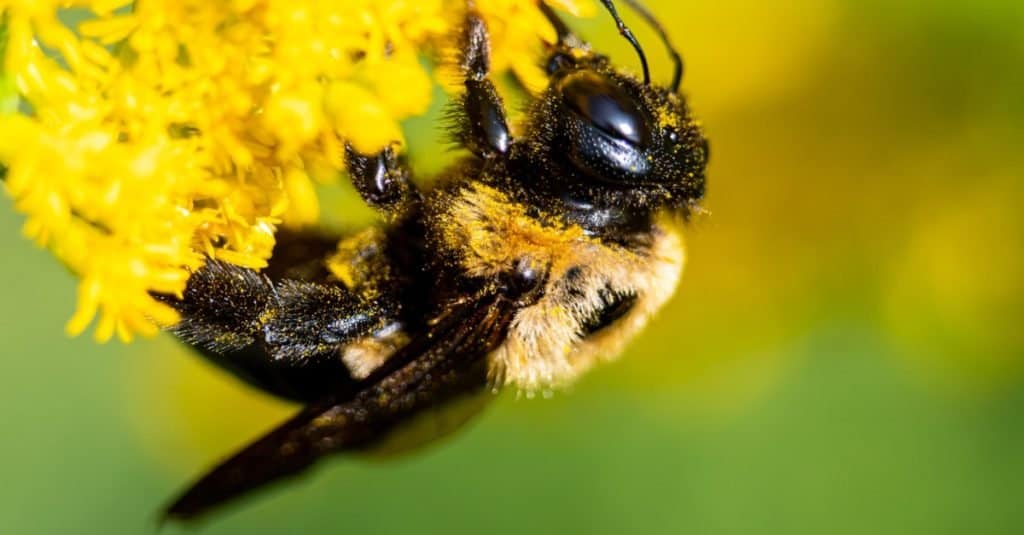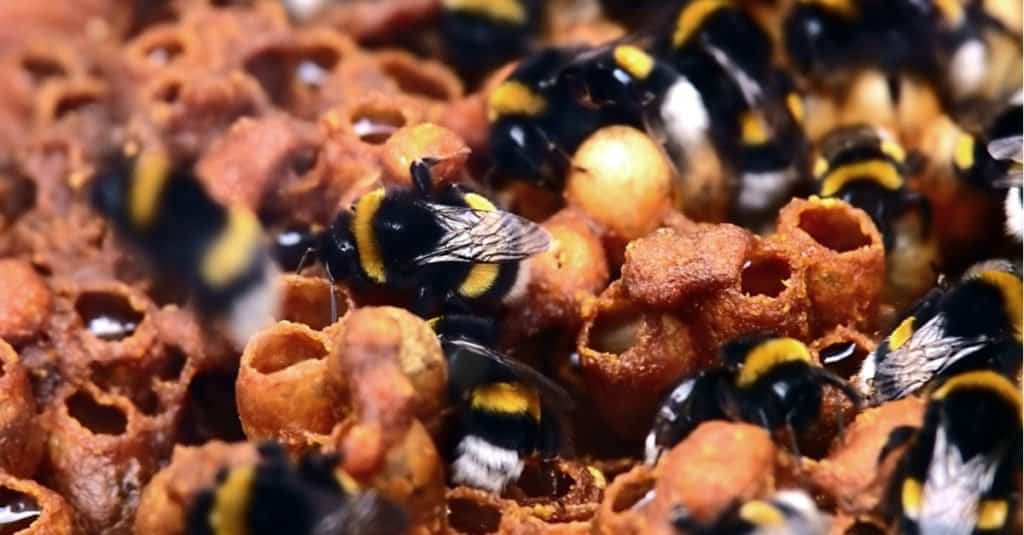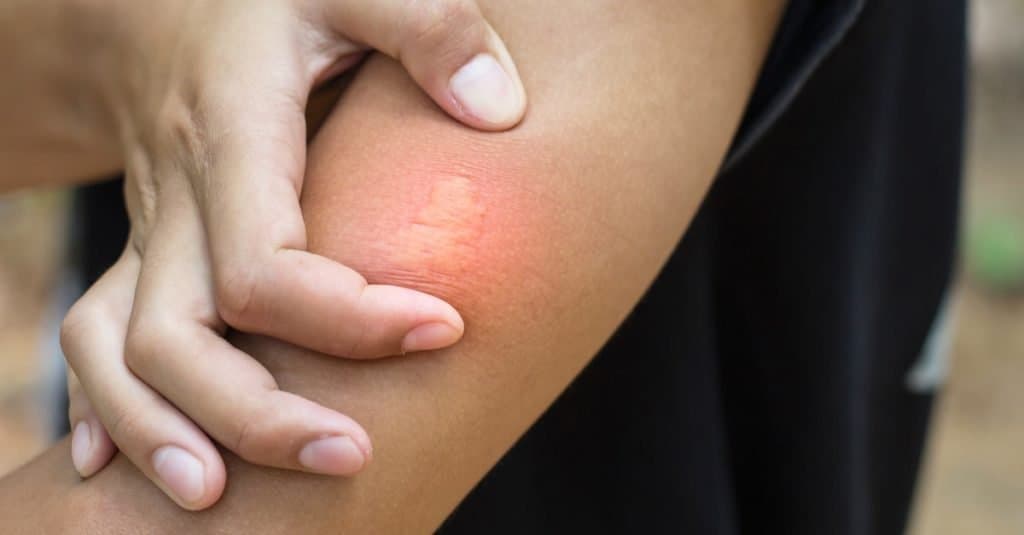Key Points
- Female bumble bees can sting but rarely do so, They will only sting if their nest is threatened or if they are continuously aggravated.
- If you are allergic to honey bee stings, you are likely to be allergic to bumble bee stings as well.
- Bumble bee nest in or near the ground.
Two-third of our crop species around the globe are dependent on pollinators for survival. Pollinators are animals that transfer pollen between female and male flower parts. Common pollinators include butterflies, birds, and bats. The most important pollinator in our ecosystems is a unique insect we spend more time running from rather than appreciating – the bumble bee.
With their stubby, short, acrylic-like wings and bulbous fuzzy, multi-colored bodies, the bumble bee hovers in the air, their wings flapping at an incredible 130 beats per second. The insect swirls around us as if it’s looking for a place to land or maybe as a threat.
Larger than typical bees, the bumble bee isn’t actually in the honey business like their relatives, the honey bee. Regardless, the bumble bee populace is critical to pollination. Otherwise, our crops and beautiful flowers would die.
Sizes
There are almost 300 species of bumble bee and they come in a variety of sizes. The largest is the queen of the Bombus dahlbomii.
Located in South America’s southern temperate forests, this queen can be 1.6 inches long. That’s almost four times larger than the largest bumble bee in the States (where a queen might hit 0.9). The world’s biggest bumble bees are in Chile and Argentina.
Worker bees are always smaller than the queen.
Habitat
Bumble bees often nest near ground surfaces. They make homes in dead leaves, piles of wood, and piles of compost. These bees also use hollow logs and grass tussocks. The creatures have even taken refuge in abandoned rodent tunnels. You can also find bumble bees in vacant bird nests and birdhouses.
What the Bumble Bee Does
Bumble bees are the construction workers of the pollination world, and they are experts at it. When the insect settles on a plant, the rapid beating of their wings and bodies creates a vibration in the flower. This in turn encourages the flower to release pollen.
We call the process buzz pollination. The process helps the plant produce more fruit.

©Brier Mitchell/Shutterstock.com
5 Facts About the Bumble Bee
The bumble bee is easily misunderstood as a predatory creature looking to sting. In reality, this is not the case! Here are some other interesting facts about bumble bees.
1. Only New Queens Survive the Cold Months
The colonies die in the late fall while the newly-born queens hibernate throughout the fall and winter. The queens awaken in the spring and lay eggs to create a new colony.
2. Bumble Bees are Social Creatures That Live in Communities
The vast majority of bee species actually don’t form hives or follow queens. They are usually solitary creatures. We tend to think all bees form communities because of the honey bee. Honey bees and the bumble bee are rare species that develop hives for shelter and family.
3. Bumble Bees are Big Business!
Bumble bees are a commercial commodity. They maintain healthy ecosystems as pollinators and without them, a lot of food markets would likely be in jeopardy. Professionally managed hives are a huge business as there is a strong demand for bumble bees to pollinate a variety of agricultural environments.
4. Bumble Bees Keep It Hot
The insects’ size generates heat. So, unlike honey bees, the bumble bee can venture into the world during cooler periods of the day and get to work. They can also climb to higher altitudes.
5. Bumble Bees Face Extinction
Several species in this family are declining rapidly and the status of many others remains in question. In the last few years, the yellow-banded, western, and Franklin bumble bee have largely vanished. The rusty-patched species is now officially endangered. Near a third of North America’s bumble bees are diminishing.
Like a great many endangered animals, bumble bees face pesticides, habitat loss, climate change, and disease. All the result of humankind’s interference in natural ecosystems.

©dwphotos/Shutterstock.com
You Can Help
If we do work outdoors, even in our small gardens, we can help sustain bumble bee life. While we hear a lot about pesticides sprayed by farmers, the average suburban homeowner is an even greater threat to pollinators. The use of pesticides to keep bugs away from homes is devastating to beneficial insects. An equal problem is the overuse of herbicides to keep lawns looking pristine. Many plants that homeowners see as weeds, such as dandelions, are a crucial food source for bees in early spring when there are few other flowers in bloom.
If you want to help, avoid using pesticides or herbicides around your home. Plant flowers that provide food for pollinators. Support organic and regenerative agriculture whenever possible. Let wildflowers flourish in your lawn. Better yet, replace it with a garden. Stop raking leaves in the fall as they provide habitat for many species of bees and they nourish the soil.
Provide Nector and Pollen
During the early spring up until the late fall, bumble bees need pollen- and nectar-producing flowers. These resources are vital food for adult bees and their larvae. We want plants native to particular ecosystems, regions, and habitats that have had no human interference or involvement. These plants evolved alongside native bees.
If you plant native plants for blooming in spring, summer, and fall, bumble bees have three seasons of food.
Give Bumble Bees Nesting Opportunities
Bumble bees nest in underground holes, abandoned rodent tunnels, empty bird nests, and birdhouses, compost piles, hollow logs, grass tussocks, and spaces under rocks. If you have these, consider leaving them intact.
Protect Habitats for Hibernation
Queens hibernate below the ground’s surface and in small holes. Your raking, mowing, and tiling risk eliminating the next generation. Hold off these activities until early spring. Set mower blades at high safe levels. Leave leaves where they fall. The natural mulch is a perfect home for pollinators like bumble bees.
Give Up Pesticides
Steer clear of herbicides and insecticides. Avoid systemic pesticides like neonicotinoids which seep into the vascular plant systems. The sustained seepage leaves pollinators exposed to poison long after you apply the product. If you plant a garden, do not use treated seeds. The chemicals coating seeds are extremally potent and become part of the entire plant and are especially concentrated in the pollen. The bees carry this poisoned pollen back to their hives and feed it to their young. This kills all the young bees before they mature and severely weaken the remaining adults.

©vallefrias/Shutterstock.com
Stinging
Do bumble bees sting? Absolutely. However, unlike honeybees, the procedure is by no means fatal to them. The reason? The absence of a barb which ensures it will not be left behind in your skin, damaging the abdomen of the belligerent arthropod, as a result.
How do bumblebees sting? Their sting’s special structure means bumblebees are capable of stinging you and returning to sting some more if the fancy takes them. They might give a warning first of all before going into attack mode and are particularly drawn to bright colors such as light blue, or the fragrances of soap or perfume.
If you are allergic to honeybee venom you will be allergic to bumblebees’ too and should ensure you always have your epipen handy and seek medical help in the event of getting stung.
Bumble bee stings are rare, as they are generally easy-going and peacefu, far more interested in pollinating than attacking humans.
Males, called drones, don’t actually have stingers. Only female bumble bees do. However, they will not attack unless their hive is at risk or they feel threatened.
What Happens After a Bumble Bee Sting?
The venom in the stinger contains elements that have a direct impact on blood vessels. Usually, the reaction is redness, serious itching, and painful swelling. If the sting takes place on looser skin, the swelling can be pronounced. In most cases, the symptoms tend to go away soon or only last a couple of days.
A sting to the throat or in the mouth is a serious matter as swelling can lead to suffocation.
Allergic Reactions
Though extremely rare, some individuals can have a bad reaction to bumble bee venom. Often, it’s due to the IgE antibodies in humans. These compounds are immune system protectors. Typically located in small amounts of blood, higher amounts may be a sign of overreaction to allergens.
People with saturated IgE may show a negative reaction. There may be no reaction in the first sting. That’s due to the unlikeliness there are antibodies before the first sting. But the next sting is likely to trigger the reaction.
The impact can be significant. Under the right circumstances, entire limbs are affected. Symptoms include itching and nettle rash. Sometimes swelling of the neck and face, diarrhea, vomiting, sweating, disorientation, and the shakes occur.
Allergic reactions to bumble bee stings worsen with each subsequent sting.
There are medications, such as beta-blockers, aspirin, or ACE-inhibitors, that may worsen the reaction to a bumble bee sting. Other threats include alcohol consumption and extensive physical activity. Anyone with an increased chance of getting stung by a bumble bee should avoid these things or ensure they have proper equipment if it were to happen. They should also get tested to know their IgE levels.
Cross Reactions
The bumble bee and honeybee have albumen structure similarities. So individuals will likely be allergic to both stings. The medical community calls this condition a cross reaction.

©WIRACHAIPHOTO/Shutterstock.com
Ways to Avoid Bumble bee Stings
Bumble bees are peaceful creatures. They hover but they actually mean no harm until they feel provoked. Here are ways to prevent getting stung.
- Do not be aggressive around bumble bees
- Avoid disturbing bumble bees
- Do not strike a bumble bee flying around you
- Manage bumble bee hives correctly
- Do not bump hives
- Stay away from perfumed smells
Ways to Deal With Stings
Here are several measures for preventing and dealing with possible stings.
- Hang notification warnings for people who may be allergic
- Keep antihistamines for anyone who’s stung
- Keep injectors of adrenaline or adrenaline injection ampoules within reach
- Know the nearest doctor or hospital location for emergency purposes
Treatment
While it’s easier said than done, if there is an allergic reaction, remain calm. Panic only makes things worse. Get to the nearest medical facility as quickly as you can.
Explain what happened and let the clinicians know if you’re dizzy or feeling other abnormalities. Most reactions are often treated with antihistamines, adrenaline, or corticosteroids. If there’s a respiratory issue, they may implement an epinephrine injection or adrenaline inhaler.
If cardiovascular problems are resulting from a sting, get the stung individual to a hospital as quickly as you can.
Desensitization
General allergic reactions to bumble bee stings are manageable with a desensitization cure. This is a specialized process that shows the body how to progressively become accustomed to a bumble bee’s venom. The tolerance training requires a unique set of procedures available only in special centers. To find one, you should consult with a doctor.
Best Garden for Bumble Bees
If you are curious about what the best plants are to add to your garden for bumble bees, here is a list of some popular ones:
- Common foxglove
- Common comfrey
- Catmint
- Borage
- Rosemary
- Red clover
Adding any of these plants into your garden will bring in more pollinators than just bumble bees, giving life to your garden. Allowing these creatures a place to stop by will also help the biodiversity of the world, believe it or not!
Up Next…
Bumble bees are essential to the world’s ecosystems and are fun to watch as they lazily fly between flowers. These and other bees differ from each other, find out how here:
- Bee Sting Vs Wasp Sting – Bees and wasps are obviously different but which has a more potent sting?
- Killer Bee vs Honey Bee: What are the Differences? – Do killer bees live up to their frightening name?
- Carpenter Bee vs Bumble Bee: What’s the Difference? – Find out how different carpenter bees and bumble bees really are.
The photo featured at the top of this post is © amypat45/Shutterstock.com
Thank you for reading! Have some feedback for us? Contact the AZ Animals editorial team.







